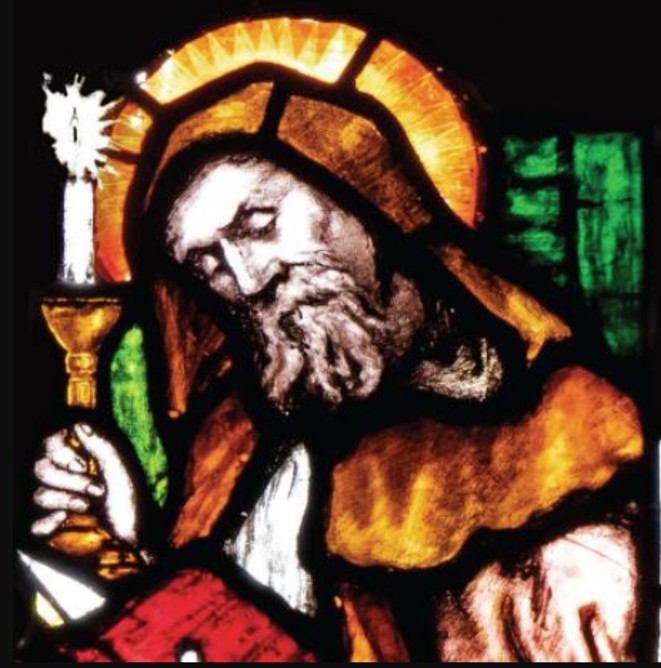
St. Eunan: image source
Nb* Much of the information here is gleaned from Omnium Sanctorum Hiberniae
Eunan was born at Drumhome near Ballintra in south-west Donegal into the Uí Chonaill family around 624. His Uí Néill lineage aligns with Loingsech, king of Tara. Eunan was educated by Columban Monks and he later joined the Iona community as a a novice in 650 before becoming the ninth abbot of Iona in 679. Eunan also became president-general of all the Columban houses in Ireland. During his term of office, he paid three lengthy visits to Ireland which brought about change.
Notable writings.
Eunan wrote “Vita Columbae” on the life of Columba, highlighting the saint’s virtues. It is full of memorable details of monks and lay people who came into contact with St. Columba. This biographical work is considered a most complete biography in all of Europe from early Christianity through to the late Middle Ages.
Eunan also wrote a book “De Locis Sanctis” on the holy places, such as Jerusalem, Damascus, Constantinople and Alexandria based on descriptions received by a French bishop Arculfus, who had been shipwrecked in western Britain and took refuge in Iona.
The English influence
On two occasions Eunan visited the court of King Aldfrid of Northumbria. Alfrid as a prince, once upon a time lived many years in exile in Ireland, and Eunan became acquainted with him. Prince Aldfrid was then recalled to the throne of Northumbria. In 686, Eunan went to visit King Alfrid to seek the release of Irish captives at that time. The English king gave a ready and favourable response to this demand; “that a complete restoration of the captives should be made [to Eunan], and that no Saxon should ever again go upon a predatory excursion to Ireland’’. Such a favourable response, no doubt cemented good relations that would foster good tidings for Ireland and England as well as the Church universal as we shall consider below…
On Eunan’s first English visit in 686, he became aware of unresolved conflicts lingering after the Synod of Whitby (664) regarding Celtic observances of the Easter calendar and the Roman observances in England. Eunan understood that the Celtic observance was was similar to St John which was the custom in the Eastern Church. Two years later Eunan visited the court of Aldfrid again, and presented the king with his invaluable work, “De Locis Sanctis,”. Eunan stayed at various religious homes in the north of England, and he became fully acquainted with the correct computation of the Easter calendar according to the Roman observance. In visiting the monasteries of Wearmouth and Jarrow, St. Eunan had lengthy discourses with the Abbot Ceolfrith.
Intervention between Celtic and Roman observance in the Irish Church
From his experience in England, Eunan would make an important contribution to the church universal regarding an reforming the Celtic practices of the their Easter calendar in Britain and Ireland. St. Eunan felt it would be better for the universality of the Church for the Celtic monastries to make use of the Roman observance. For eighteen years St. Eunan made it his business to convince Ionian monks in Scotland as well as and the Irish Columban monasteries to switch to the roman observance during his office as president. Thus Eunan became a devoted champion of the Whitby Synod. This reform of the Celtic church was a slow progress across Ireland, which was later accelerated by St. Malachy some centuries later.
The law of innocents – a type of old Irish ‘Geneva Convention’
In 697 Eunan visited Ireland a third time, and obtained a decree from the Irish princes that men alone should be subject to military service. This seems to be linked in some way to another notable influence of Eunan; The law of innocents – a type of Irish ‘Geneva Convention’ which was decreed at the Synod of Birr. There he convinced the participants that, women, children and clerics should be exempt from war and not be taken prisoners or slaughtered. This came to be known as Eunan’s law.
In the Laebhar Breac it reads of four chief Irish laws: “Patrick’s Law, that the clerics should not be killed; Bridget’s Law, that the cattle of thy shall not be killed; Eunan’s Law, that women shall not be killed; and the Law of the Lord’s-day, that it be not desecrated.”
Eunan was a man of great austerities and his ascetic life is compared with the great fathers and hermits of the Egyptian deserts. St. Bede refers to Eunan as “a good and a wise man, and remarkably learned in the knowledge of the Scriptures.”
He died at the Abbey in Iona in 704. He is the Patron of Raphoe Diocese. He is celebrated on the 23rd of September.